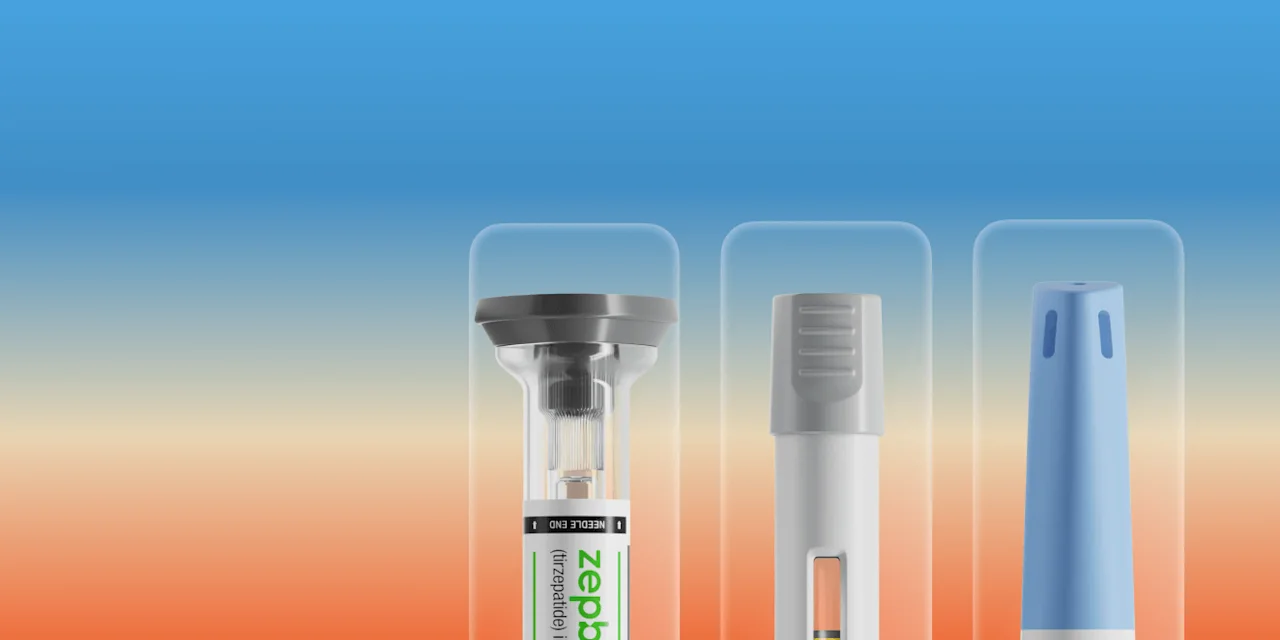Key takeaways
Mounjaro is used to manage blood sugar in people with diabetes and can help with weight management as well.
The common side effects include nausea, abdominal pain, vomiting, and diarrhea, as well as other digestive issues, but these typically resolve over time.
More serious side effects can include pancreatitis and hypoglycemia or low blood sugar and may require immediate medical attention.
Here's what we'll cover
Key takeaways
Mounjaro is used to manage blood sugar in people with diabetes and can help with weight management as well.
The common side effects include nausea, abdominal pain, vomiting, and diarrhea, as well as other digestive issues, but these typically resolve over time.
More serious side effects can include pancreatitis and hypoglycemia or low blood sugar and may require immediate medical attention.
Mounjaro (tirzepatide) is part of a class of FDA-approved injectable medications that help people with type 2 diabetes control their blood sugar levels and lose weight. Mounjaro is similar to medications like Ozempic (semaglutide) and Trulicity (dulaglutide) in both how it works and possible side effects.
The gastrointestinal side effects of Mounjaro are manageable. People commonly have nausea, diarrhea, reduced appetite, vomiting, constipation, indigestion, and stomach pain. Serious side effects are rare, but may include pancreatitis (inflammation of the pancreas), kidney or gallbladder problems, or an allergic reaction to Mounjaro.
Additionally, people taking insulin may have a higher risk of experiencing hypoglycemia (low blood sugar) when taking Mounjaro, and those with diabetic retinopathy (vision damage from diabetes) may be more likely to experience complications.
Generally, side effects with Mounjaro are more common when you first begin taking the medication and tend to subside as your body gets used to the drug. People taking higher doses of Mounjaro may also be more likely to experience side effects.
Below, we take a look at the common side effects of Mounjaro, and what you can do to relieve any discomfort.
Mounjaro Important Safety Information: Read more about serious warnings and safety info.
1. Nausea
Nausea is the most common side effect of Mounjaro. In clinical trials, up to 18% of people experienced nausea while taking Mounjaro.
As with many Mounjaro side effects, higher doses of Mounjaro may bring a higher risk of side effects. With that in mind, it is no surprise that 18% of people who experienced nausea took the highest dose of Mounjaro — 15 mg —, while only 12% of those taking 5 mg did.
If you experience nausea while taking Mounjaro, Eli Lilly, the manufacturer of Mounjaro, recommends the following:
Eating smaller meals
Eating bland foods like crackers or rice
No longer eating once you feel full
Drinking clear liquids, like water, can also help you manage nausea and stay hydrated.
2. Diarrhea
As many as one in six people experience diarrhea when taking Mounjaro. Those taking higher doses of Mounjaro may be more likely to have diarrhea. Like other side effects, diarrhea is most common when you begin using Mounjaro and goes away with time.
Diarrhea can lead to dehydration, so it is important to keep drinking water and clear fluids if you experience this side effect.
3. Decreased appetite
Decreased appetite is a common side effect of Mounjaro, affecting as many as one in ten people.
Part of this may be due to how Mounjaro works. As a dual glucose-dependent insulinotropic polypeptide (GIP) receptor and glucagon-like peptide-1 (GLP-1) receptor agonist, Mounjaro slows down digestion. Since it takes longer for food to leave your stomach, you may feel full sooner, and notice you have less of an appetite. As a result, people tend to lose weight while taking Mounjaro, which can be helpful if weight loss is part of their diabetes treatment plan.
Talk with a dietitian if you are concerned your reduced appetite will affect your ability to eat a nutritious diet.
4. Sagging skin
Mounjaro can lead to significant weight loss. In a study of people with obesity, participants lost between 15% to nearly 21% of their body weight within a year and a half after starting Mounjaro. Sagging or droopy skin can occur with significant weight loss, especially when the weight loss occurs rapidly. Some people notice their face takes on a more wrinkly appearance.
Sagging skin is a normal byproduct of significant weight loss. If you start to notice droopy skin, you can take several measures to combat it, from staying hydrated and practicing good skin care to exploring cosmetic procedures like soft tissue fillers.
5. Vomiting
According to clinical trials, 5% to 9% of people may experience vomiting when they get on Mounjaro. As with other side effects, the likelihood of vomiting tends to increase with higher doses of the drug.
The good news is that for most people, vomiting is a manageable side effect that occurs more often when they first start taking Mounjaro and goes away as their body gets used to the drug. In rare cases, it can be a sign of something more serious, like pancreatitis. If you experience vomiting with severe stomach pain that doesn’t go away, stop using Mounjaro and contact your healthcare provider immediately.
Vomiting can lead to dehydration. Stay hydrated by drinking plenty of water if you experience vomiting.
6. Constipation
Up to 7% of people experience constipation when taking Mounjaro. While you don’t need to have a bowel movement every day, having three or less in a week can be a sign that you’re constipated.
Usually, constipation goes away on its own, but you can take a few steps to prevent it. For example, getting regular exercise and drinking enough water both prevent constipation. Health experts also recommend eating more fiber-rich foods, such as fruits, vegetables, and grains.
7. Indigestion
Fewer than one in ten people experience dyspepsia, or upset stomach, when taking Mounjaro. This side effect was more commonly reported in clinical trials among people taking 5 mg or 10 mg of Mounjaro.
Certain eating habits can make indigestion feel worse. To prevent indigestion, try to avoid:
Drinking alcohol or caffeinated beverages
Eating fatty, greasy, or spicy foods
Eating too quickly
Additionally, smoking and stress can contribute to an upset stomach. Eat slowly and chew your food completely to prevent an upset stomach.
8. Abdominal pain
Around 5% of people experience stomach pain while using Mounjaro. If this happens to you, try relaxing with a warm bath or placing a heating pad over your belly.
In rare cases, abdominal pain can be a sign of pancreatitis, a serious inflammation of the pancreas. If you experience severe stomach pain that does not go away, contact your health provider immediately. You may feel the pain radiate to your back, and you may or may not experience vomiting as well.
9. Pancreatitis
Pancreatitis (inflammation of the pancreas) is a rare, but serious, side effect of Mounjaro. It’s characterized by severe abdominal pain that does not go away, and may or may not radiate to the back or be accompanied by vomiting.
If you start noticing these effects, contact a healthcare professional immediately and stop using Mounjaro. You may need to be treated with intravenous (IV) fluids, pain medications, or antibiotics.
10. Hypoglycemia
People who take insulin to manage their diabetes may be at increased risk of experiencing hypoglycemia, or low blood sugar, when using Mounjaro. Signs of low blood sugar include:
Dizziness
Sweating
Confusion
Headache
Blurred vision
Slurred speech
Shakiness
Hunger
Weakness
Feeling jittery
Anxiety, irritability, or mood changes
Keep an eye on your blood glucose levels while taking Mounjaro. If they dip below 70 mg/dL, that’s considered low. If your blood sugar is between 55-69 mg/dL, follow the 15-15 rule. Eat 15 grams of carbs (e.g. a half cup of juice, a tablespoon of honey, or a few jellybeans). Wait 15 minutes and recheck your blood sugar. If it’s still low, repeat the process. If your blood sugar is below 55 mg/dL, seek emergency medical attention.
Before starting Mounjaro, tell your healthcare provider about any medication you are taking, including insulin or sulfonylureas. They may lower your dose of insulin to prevent your chances of experiencing low blood sugar.
11. Kidney problems
The gastrointestinal side effects of Mounjaro — namely nausea, vomiting, and diarrhea — can cause dehydration. If the dehydration is severe enough, it may lead to kidney damage, both in people with pre-existing renal failure and those without kidney issues before.
While rare, acute kidney injury has been reported in people taking GLP-1 receptor agonists, like Mounjaro. Before starting Mounjaro, tell your healthcare provider if you have any history of kidney problems.
Contact your health provider if you’re urinating less than normal despite normal fluid intake (a potential warning sign of kidney damage). If you experience vomiting, diarrhea, and nausea while taking Mounjaro, rehydrate with plenty of water.
12. Diabetic retinopathy complications
Diabetic retinopathy describes vision damage that can occur in people with type 2 diabetes. Sudden improvement in blood glucose control, which may occur with Mounjaro, may temporarily worsen diabetic retinopathy. While this Mounjaro side effect is rare, people with a history of diabetic retinopathy may be more likely to experience complications while taking Mounjaro.
If you notice any vision changes while taking Ozempic, contact your health provider. These may include blurred vision, seeing floaters, or partial or total vision loss.
13. Gallbladder problems
It’s rare, but a small percentage (less than 1%) of people may develop gallstones while taking Mounjaro or other GLP-1 medications. The biggest warning sign of gallbladder disease is sharp stomach pain that doesn’t go away. You may also experience nausea, sweating, or vomiting.
If you experience these symptoms, contact a health professional immediately. You may need surgery to remove the gallbladder, which is known as a cholecystectomy. Losing weight, exercising regularly, and following a low-fat diet can help prevent gallbladder issues.
14. Thyroid tumors
Animal studies have found tirzepatide (the active ingredient in Mounjaro) causes thyroid C-cell tumors in rats. While it is not known if Mounjaro has the same effect in humans, the U.S. Food and Drug Administration (FDA) has issued a boxed warning for the drug due to the increased risk for people with a personal or family history of medullary thyroid carcinoma (MTC) or Multiple Endocrine Neoplasia syndrome type 2 (MEN 2).
Tell your healthcare provider if you have a history of thyroid cancer in your family, as you should not use Mounjaro.
People who are pregnant or breastfeeding should also avoid taking Mounjaro.
15. Other Mounjaro side effects
Above, we’ve reviewed the most common side effects of Mounjaro. However, there are a few others you may experience while taking this diabetes medication.
Some people experience other gastrointestinal side effects while taking Mounjaro, including burping, flatulence, gastroesophageal reflux disease (GERD), or a distended abdomen. Typically, these Mounjaro side effects affect 3% of people or less.
Here is how long Mounjaro side effects can last.
In clinical trials, some people experienced a slightly increased heart rate (tachycardia) while taking Mounjaro.
A small number of people experience an injection site reaction from Mounjaro, which may present as mild redness around the area where you injected the Mounjaro pen. This is different from a serious allergic reaction (e.g. rash, itching, or trouble breathing), which requires immediate medical attention.
If you are allergic to tirzepatide or any of the following inactive ingredients in Mounjaro, inform your health provider before taking Mounjaro:
Sodium chloride
Sodium phosphate dibasic heptahydrate
Hydrochloric acid solution
Sodium hydroxide solution
Additionally, it’s worth noting that Mounjaro slows down digestion, which may affect the absorption of any other medications you may be taking. Before starting Mounjaro, talk to your health provider about any prescription drugs or over-the-counter supplements you are taking.
For most people taking Mounjaro, side effects are mild to moderate, and go away as your body gets used to the medication. If you experience any side effects that concern you, talk to your healthcare provider.
DISCLAIMER
If you have any medical questions or concerns, please talk to your healthcare provider. The articles on Health Guide are underpinned by peer-reviewed research and information drawn from medical societies and governmental agencies. However, they are not a substitute for professional medical advice, diagnosis, or treatment.
Centers for Disease Control and Prevention (CDC). (2022). How to Treat Low Blood Sugar. Retrieved from https://www.cdc.gov/diabetes/basics/low-blood-sugar-treatment.html
Chavda, V. P., Ajabiya, J., Teli, D., et al. (2022). Tirzepatide, a New Era of Dual-Targeted Treatment for Diabetes and Obesity: A Mini-Review. Molecules (Basel, Switzerland), 27(13), 4315. doi:10.3390/molecules27134315. Retrieved from https://pubmed.ncbi.nlm.nih.gov/35807558/
Elander, A., Biörserud, C., Staalesen, T., et al. (2019). Aspects of excess skin in obesity, after weight loss, after body contouring surgery and in a reference population. Surgery for Obesity and Related Diseases, 15(2), 305–311. doi:10.1016/j.soard.2018.10.032. Retrieved from https://pubmed.ncbi.nlm.nih.gov/30638792/
Evert, A. B., Dennison, M., Gardner, C. D., et al. (2019). Nutrition therapy for adults with diabetes or prediabetes: A consensus report. Diabetes Care, 42(5), 731–754. doi.10.2337/dci19-0014. Retrieved from https://pubmed.ncbi.nlm.nih.gov/31000505/
Farzam, K. & Patel, P. (2022). Tirzepatide. StatPearls. Retrieved from https://www.ncbi.nlm.nih.gov/books/NBK585056/
Goyal, A., Daneshpajouhnejad, P., Hashmi, M. F., et al. (2023). Acute Kidney Injury. StatPearls. Retrieved from https://pubmed.ncbi.nlm.nih.gov/28722925/
Jastreboff, A. M., Aronne, L. J., Ahmad, N. N., et al. (2022). Tirzepatide Once Weekly for the Treatment of Obesity. The New England Journal of Medicine, 387(3), 205–216. doi:10.1056/NEJMoa2206038. Retrieved from https://pubmed.ncbi.nlm.nih.gov/35658024/
Lilly. (n.d.). How to Use, Dosing & Side Effects | Mounjaro® (tirzepatide). Retrieved from https://www.mounjaro.com/how-to-use-mounjaro#possible-side-effects
Liska, D., Mah, E., Brisbois, T., et al. (2019). Narrative Review of Hydration and Selected Health Outcomes in the General Population. Nutrients, 11(1), 70. doi:10.3390/nu11010070. Retrieved from https://pubmed.ncbi.nlm.nih.gov/30609670/
Liu, M. H., Beynet, D. P., & Gharavi, N. M. (2019). Overview of Deep Dermal Fillers. Facial Plastic Surgery, 35(3), 224–229. doi:10.1055/s-0039-1688843. Retrieved from https://pubmed.ncbi.nlm.nih.gov/31189194/
MedlinePlus. (2020). Nausea and Vomiting. Retrieved from https://medlineplus.gov/nauseaandvomiting.html
MedlinePlus. (2019). Dehydration. Retrieved from https://medlineplus.gov/dehydration.html
MedlinePlus-a. (2016). Constipation. Retrieved from https://medlineplus.gov/constipation.html
MedlinePlus. (2021). Indigestion. Retrieved from https://medlineplus.gov/ency/article/003260.htm
MedlinePlus-b. (2016). Period Pain. Retrieved from https://medlineplus.gov/periodpain.html
MedlinePlus-c. (2016). Pancreatitis. Retrieved from https://medlineplus.gov/pancreatitis.html
Rodan, K., Fields, K., Majewski, G., et al. (2016). Skincare Bootcamp: The Evolving Role of Skincare. Plastic and Reconstructive Surgery. Global Open, 4(12 Suppl Anatomy and Safety in Cosmetic Medicine: Cosmetic Bootcamp), e1152. doi:10.1097/GOX.0000000000001152. Retrieved from https://pubmed.ncbi.nlm.nih.gov/28018771/
Shukla, U. V. & Tripathy, K. (2023). Diabetic Retinopathy. StatPearls. Retrieved from https://pubmed.ncbi.nlm.nih.gov/32809640/
Tanaja, J., Lopez, R. A., & Meer, J. M. (2022). Cholelithiasis. StatPearls. Retrieved from https://pubmed.ncbi.nlm.nih.gov/29262107/
U.S. Food and Drug Administration (FDA). (2022). Highlights of Prescribing Information: MOUNJARO (tirzepatide) Injection, for subcutaneous use. Retrieved from https://www.accessdata.fda.gov/drugsatfda_docs/label/2022/215866s000lbl.pdf












